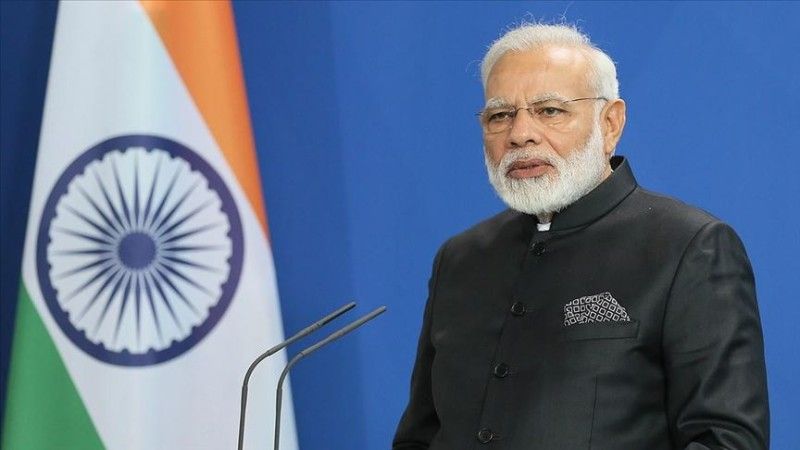Indian Prime Minister Visits Poland [INTERVIEW]

Narendra Modi, the Prime Minister of India, is visiting Poland today, marking the first visit by an Indian Prime Minister since 1979. The key topics of discussion will include the revitalization of bilateral relations, with a particular focus on defence cooperation and strategic planning. Economic issues will also be addressed. Notably, India has, for the first time in several decades, appointed its Defence Attaché in Warsaw this year. Modi will meet with President Andrzej Duda and Prime Minister Donald Tusk. He will also visit the Tomb of the Unknown Soldier and the memorial for the Battle of Monte Cassino. Poles and Indians were part of the large Allied coalition in major battles at Tobruk and Monte Cassino in 1944. Following these events, the Indian Prime Minister will, for the first time in history, travel to Ukraine. Is New Delhi aiming to play a role in resolving the Russian-Ukrainian conflict?
We are currently anticipating a new chapter in relations between Poland and India. Dr. Jagannath Panda from the Stockholm Center for South Asian and Indo-Pacific Affairs at ISDP in Sweden answered questions about cooperation, including defence cooperation, plans regarding Ukraine, and rivalry with China.
Leaving for Warsaw. This visit to Poland comes at a special time- when we are marking 70 years of diplomatic ties between our nations. India cherishes the deep rooted friendship with Poland. This is further cemented by a commitment to democracy and pluralism.
— Narendra Modi (@narendramodi) August 21, 2024
I will hold talks…
Aleksander Olech: Why is Prime Minister Modi’s visit to Poland important?
Dr. Jagannath Panda from the Stockholm Center for South Asian and Indo-Pacific Affairs at ISDP in Sweden: Poland is emerging as a strategic hub in Europe. Given that India is poised to expand its ties with Europe, New Delhi needs to develop a partnership with Poland, a vital transition state and an important corridor state between Eastern and Western Europe. Poland is on track to become a model rising economy in the European space, and that is a referral point for any major Asian or Indo-Pacific power including India to stay connected with Poland in different fields. More importantly, Poland is steadily executing its Asia-connect plan, and this is a time when India must exhibit interest in stronger ties with Poland. Hence, Prime Minister Narendra Modi’s visit to Poland is certainly a timely one.
Besides, what must encourage India to look at Poland as a »future« partner in strategic field is Poland’s sturdy resistance to an authoritarian mix on its border that has a stronger Russia-China alignment plan. Going forward, Poland’s plan of taking the lead in the European platforms against an authoritarian mix must encourage India to look at Poland differently, and as a key partner to expand India’s outreach in the Central and Eastern European venues. In fact, given India’s growing strategic interest in the Baltic space to Central and Eastern European countries, Poland could not only be a »gateway« for India’s trade and economic engagement but also a channel of strategic communication for India’s rising engagement in the region for a better diplomatic, political and strategic involvement. In the European strategic space, there is perhaps no better country than Poland at present that could be a vital partner for India given that Poland’s influence in the European Union is rising steadily.
In which sectors can Poland and India expand their cooperation? Which elements are the most important?
It is time for India and Poland to expand a partnership that could be labelled as a »strategic« and »comprehensive« one. However, what is important to mention is that an outright expansion in partnership is not possible unless a roadmap is prepared, and specific sectors are chosen to execute such a roadmap. Hence, three specific areas that could be vital for India-Poland future engagement are educational linkages, tourism, and defence partnerships.
The educational link between Poland and India could also be a capital venture of any future engagement given the Polish people’s positive impression of India as a power in the making. Student exchanges and greater intellectual exchanges at the university-to-university, think-thanks-to-think-tanks must be carried out. Besides, this must supplement the media coverage on both sides that must be expanded to raise awareness of each other. This will also promote the tourism sector engagement. Poland’s attractions include a mix of both urban and rural tourism, and efforts to woo Indian tourists will undoubtedly pay off. Likewise, India’s vast cultural space could be a greater tourist attraction for the Polish people, and such a space will only enhance people-to-people interaction.
Defence and security ties too must be expanded steadily. Poland has emerged as a critical defence manufacturing country in Central Europe, and India must take strong note of this. Poland’s defence engagement with South Korea is on the ascendancy. Though previously Poland has supplied arms to India, still such past experiences must be seen and revived and strengthened in a new strategic context. Post the Ukraine war, Poland has emerged as a critical supplier of arms to Ukraine, thereby boosting its credibility that it is poised to challenge any authoritarian build-up across its border. That must encourage India to look at Poland positively and explore if India’s »Make in India« program can boost India-Poland joint manufacturing and production in the defence sector. Besides, Poland has a strong history of cooperation with NATO, and India could gain significantly by cooperating with Poland to share 21st-century combat experiences and battlefield experiences, etc. Any expansion in the defence sector is eventually going to boost trade and economic ties since defence trade is a vital component of overall trade and economic engagement.
Is military cooperation between the two countries feasible? Is it realistic to jointly develop a combat vehicle, missile, or other component?
Defence ties or military-to-military cooperation shows great potential, and it must be the reference point for a comprehensive engagement between the two countries in times to come. As I mentioned, India’s current »Make in India« plan welcomes overseas capital and partnerships to come to India and enter into joint production and manufacturing. So, it is possible to develop a joint plan to co-produce combat vehicles, missiles, tanks, etc. India’s private manufacturing players in the defence sector must have a collaborative platform for engagement with the Polish defence companies. Regular dialogue, exchange of visits, and sharing of platform through seminars and conferences could lead such exchanges and interactions further. Building confidence in each other’s capability is key here.
Besides, for India, defence and security engagement with Poland can offer several strategic gains. For example, India’s defence units and agencies can learn from Poland on how to fight and prepare for alliance operations and missions. Poland’s 25 years of experience with NATO can come as a useful learning experience on how to stay prepared to engage in the context of a collective security or collective defence environment. Additionally, Poland’s armed forces are becoming more sophisticated with technical modernization, reform of the command system capabilities, and adapting to the sophisticated technological capabilities in the military space by engaging with NATO. As India prepares to reduce its dependency on importing Russian military equipment and plans to import more and more from Western arms manufacturers, it will be a huge gain for India to learn from Poland’s adoption strategy in the military space.
Likewise, Poland can be a vital partner in India’s journey in defence sector modernization. Concurrently, India is also prioritizing co-production with technologically advanced „like-minded” states such as the United States, France, the European Union (EU), Israel, and South Korea. Its recent cutting-edge technological defence cooperation efforts with the United States and semiconductor collaboration under the framework of the EU-India Trade and Technology Council appear promising, with buy-in from each partner. This will not just help India create forward-looking Indo-Pacific mechanisms, but also give momentum to India’s high-tech-oriented manufacturing makeover. Poland should take strong note of this Indian plan and must craft a collaborative effort with India in security and defence areas of cooperation that involve critical technologies.
What role could India play in ending the Russia-Ukraine war? China hasn’t succeeded, France hasn’t either, and the USA has also seen no breakthrough. Could Prime Minister Modi change the course of events?
Neither is India keen to play a role between Russia and Ukraine nor is it aiming to emerge as a mediator to solve the Russia-Ukraine war. At the same time, India doesn’t promote a war theory and New Delhi would like the war between Russia and Ukraine should be stopped, and has therefore been advocating for peace. What we should take strong note of is the fact that the Russia-Ukraine war is not just an outcome between these two confronting nations. It is a product of the major power politics, and importantly, the failure of the post-Cold War peace architecture that Europe-Russia maintained for some time. Keeping all these aspects in background, India actually has little role to play. The war can only be stopped if Europe and Russia-China can have a better understanding which looks unlikely at present. China is backing Russia outrightly, and the EU member states including Poland should take a strong note of China’s non-intention to stop the war. In a way, it would be appropriate to say that China has boosted Russia’s war game plan against Ukraine, and Europe at large.
How does India view China’s increasing defence spending and rising regional tensions?
For India, China is a threat in the immediate neighbourhood and beyond. China’s military modernization and its continuous growth in defence budget are huge areas of strategic concern for India and the world. Besides, the PLA’s aggressive approach on the boundary dispute with India comes as a serious challenge. China’s aggressive foreign policy posture and its expanding blue water naval capability under Xi Jinping have also become a concern regionally in various maritime zones, from the South China Sea and the East China Sea to the larger Indian Ocean space.
Given the rising trade deficit with China, what is New Delhi’s outlook on supply chain resilience and reducing its dependency on China?
Even though trade and economic contacts between India and China are still on the rising curve, New Delhi is highly motivated to reduce dependence on China and is building alternative global value chains that do not put China at their center. For this purpose, after beginning negotiations in 2020, in April 2021, India launched the Supply Chain Resilience Initiative (SCRI) with Japan and Australia at the Ministerial level. The platform acts as a mechanism to coordinate risk management efforts and continuity plans to avoid undue disruptions to supply chains in the face of future »black swan« events like the COVID-19 pandemic. It promotes the sharing of best practices on supply chain resilience. Additionally, holding of investment promotion and buyer-seller matching events between the three countries seeks to encourage private sector stakeholders to explore opportunities away from China by de-risking and therefore diversify their supply chains.
Here, the EU can emerge as a key partner for the SCRI, and India particularly. Yet, at present, the EU-India trade relationship remains far below its potential. With India’s impetus on expanding its manufacturing capacity and fostering a positive business environment through its Atmanirbhar Bharat post-pandemic recovery plan and enhanced Production Linked Incentive (PLI) Scheme to boost manufacturing within India, their bilateral potential be tapped effectively. A focus on production in India would in turn help reduce excessive reliance on China-centric value chains and improve resilience. As political ties with China become ever-more complex, a focus on India in the EU’s geo-economic vision will help further a »China Plus« strategy and secure value chains. Poland can play a stronger partnering role with India, both bilaterally and also within the larger ambit of India-EU ties.
Similarly, supply chains are also a focus under the EU’s Global Gateway, which was introduced in 2021 and has swiftly become a cornerstone for the implementation of the EU’s Indo-Pacific strategy. With a commitment of €300 billion in investments, the Global Gateway is, in some ways, Europe’s modest answer to China’s Belt and Road Initiative or BRI. It comes as an extension of the EU-Asia and EU-India connectivity partnership and looks to improve cross-continental connectivity, which is bound to enable further diversification of supply chains. Hence, there is an obvious space for Poland to play a stronger role with India, both bilaterally and within the India-EU partnerships.
Thank you for the conversation.
Dr. Jagannath Panda is the Head of the Stockholm Center for South Asian and Indo-Pacific Affairs (SCSA-IPA) at the Institute for Security and Development Policy, Sweden; and a Professor at the Department of Regional and Global Studies at the University of Warsaw.



